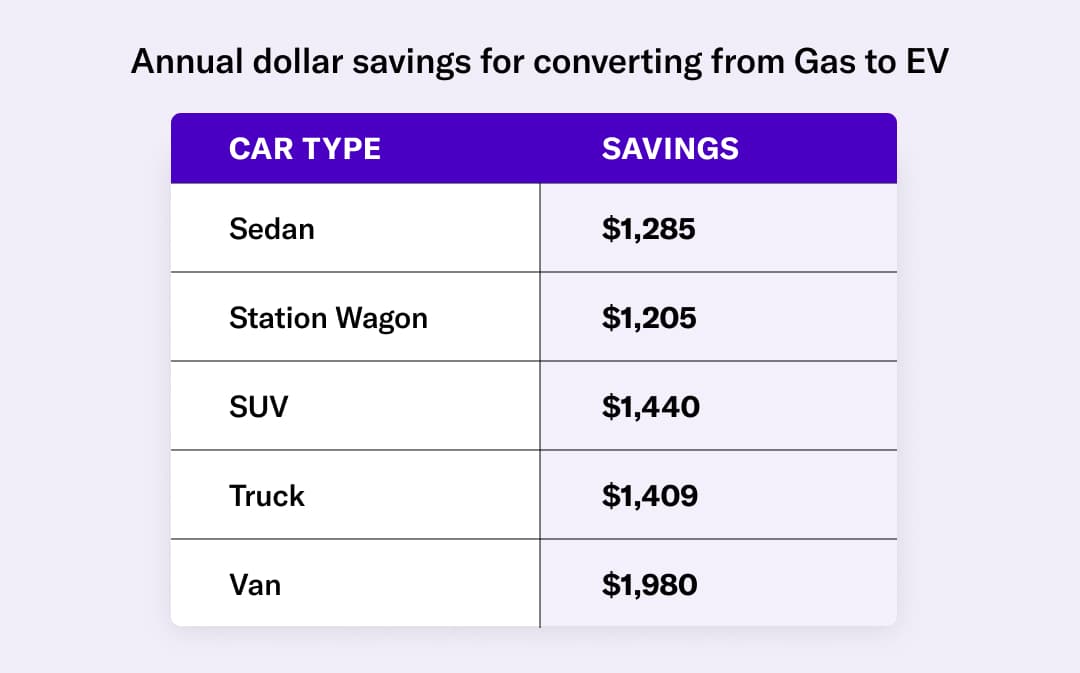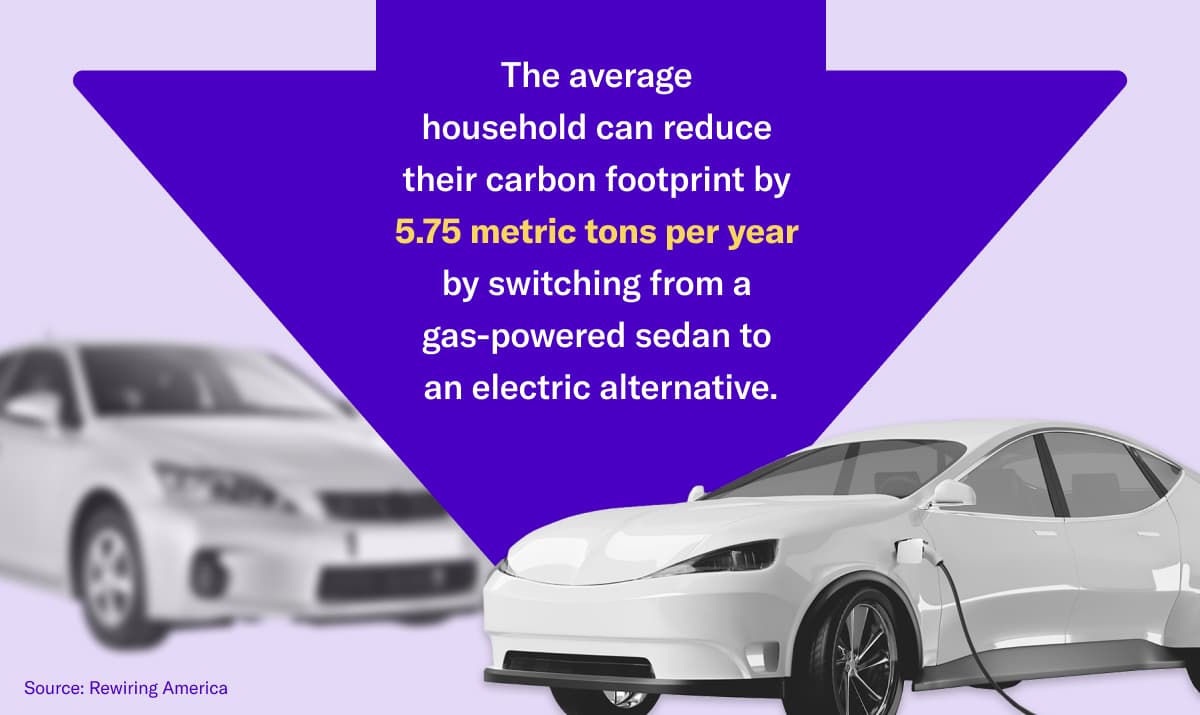Gas vs electric cars: Here's how much money you can save with EVs

If you drive a gas-powered car, you’ve probably wondered whether your next vehicle should be electric. And like a lot of other drivers thinking about buying an electric vehicle (EV), you might also be asking some important questions: What are my choices? Will an EV save me money? How much better for the environment is it? Will I be able to drive wherever I want?
Below, we’ll break down the big differences between EVs and internal combustion engine (ICE) vehicles. We’ll explain why EVs already win out in virtually every scenario, and why the case for switching from gas to great is getting stronger every year.
Types of electric vehicles
Before making up your mind about whether an EV is right for you, it’s important to know what your options are.
There are three types of EVs on the market: battery electric vehicles, hybrid electric vehicles, and plug-in hybrid electric vehicles. These are sometimes shortened to BEVs, HEVs, and PHEVs.
The three types of EVs differ from one another in one big way. Battery electric vehicles (which may also be referred to as fully electric vehicles or all-electric vehicles) don’t burn any gasoline. Hybrids, on the other hand, do.
Battery electric vehicles (BEVs) are what you probably picture when you think of an EV. They’re powered entirely by batteries, and they need to be plugged in to recharge. People who own this type of EV typically charge them overnight, at home. On the rare occurrence that drivers need to drive for more than 5 or 6 hours in a day, they charge up at public charging stations. Most new battery electric vehicles sold today can cover 200 to 300 miles on a single charge, and their range is continuing to climb.
Hybrid electric vehicles (HEVs) run on battery power some of the time but also require gasoline. Hybrids charge their batteries through a combination of internal combustion and regenerative braking — a process that captures and stores some of the energy created when a driver hits the brakes. The best way to think of these vehicles is like a more efficient gas-powered car.
Plug-in hybrid electric vehicles (PHEVs) resemble other hybrids, but they don’t always burn gasoline. As the name suggests, their batteries are designed to be plugged in to charge. Ordinarily, that enables them to go short distances — like a daily commute — on battery power, aided by regenerative braking. When a plug-in hybrid’s battery power runs out, its internal combustion engine kicks in.
Costs of gas vs. electric cars
The average sticker price of a new EV can be thousands of dollars higher than the average sticker price of a new gas car. This is partly because EV batteries contain expensive materials like lithium, cobalt, and nickel, and partly because EV supply chains tend to be smaller and newer than their ICE counterparts. (Hybrids also cost more, on average, than ICE vehicles, but that price gap is often smaller.)
The truth is that upfront costs can be misleading. Throughout their life, electric cars save their owners thousands of dollars. That’s because they don’t require gasoline or nearly as much maintenance.
Cost of electricity vs. gasoline
The exact numbers will depend on where you live since gasoline prices and electricity prices vary by region. But according to an analysis by the Washington Post, electric charging is cheaper than pumping gas in all 50 states.
EVs save sedan drivers between $22 and $59 and SUV drivers between $14 and $49 each time they fill their battery. The more you drive, the more those savings add up. Over a year, the average household can save between $1,285 and $1,980 per year on gasoline costs alone, according to an analysis by our team at Rewiring America.
EV vs. gas car maintenance
On average, EV owners pay less for maintenance, too. An all-electric vehicle doesn’t use motor oil, for example, making regular oil changes a thing of the past.
The Department of Energy found in 2021 that battery electric vehicles’ maintenance costs come out to 6.1 cents per mile, compared with 10.1 cents per mile for ICE vehicles, 9.4 cents per mile for standard hybrids and 9 cents per mile for plug-in hybrids.

More recent stats from Kelley Blue Book show that EV owners, on average, have saved a little more than $300 on maintenance and repairs over five years compared with owners of ICE vehicles. (The total maintenance costs over 5 years came out to $5,958 for EVs and $6,278 for ICE vehicles.) Consumer Reports concluded in June 2023 that EVs continue to outperform ICE vehicles on fuel, maintenance, and repair costs over their lifetimes.
The math is clear. Electric cars are much cheaper to own than gas-powered cars, and they're becoming more affordable to purchase, too.
Rebates and government incentives
Federal tax credits for new EVs have been available for years, and with the passage of the Inflation Reduction Act (IRA) in 2022, they will be available at least through 2032.
To qualify for part or all of the tax credit, manufacturers now have to source a certain amount of their battery components and critical minerals from North America or from countries that have a free-trade agreement with the U.S.
About a dozen battery electric vehicles and plug-in hybrids are currently eligible for the full $7,500 credit and many more meet the requirements for a partial $3,750 credit. The list of used vehicles that qualify for a new tax credit for used EVs of up to $4,000 is even longer.
With the help of these tax credits, according to Consumer Reports, an EV’s total savings may soar to between $6,000 and $12,000 over its lifetime.
And starting in 2024, you'll be able to cash in on these credits at the time of purchase, as long as you meet income requirements. You can visit our IRA calculator to see how much you can save on EVs.
To make the deal even sweeter, many states, municipalities, and electricity providers are also rolling out their own EV incentives. Some states offer thousands of dollars off the price of a new EV. California, for example, offers a rebate of up to $7,500! In Colorado and Vermont, you can get up to $5,000.
The Department of Energy keeps a database of state EV programs. Find your state here.
Environmental impacts of EVs
You may have heard that making EVs — and the battery packs that power them — hurts the environment.
It's true that battery electric vehicles have a more carbon-intensive manufacturing process, but ICE vehicles are still responsible for many times more carbon emissions over their lifetimes. That’s because burning gasoline throughout its lifetime releases tons of planet-warming greenhouse gases.

In fact, according to our research at Rewiring America, the average household can reduce their carbon footprint by 5.75 metric tons per year just by switching from a gas-powered sedan to an electric alternative. The electric grid that powers EVs is getting cleaner every year, and the amount of electricity produced by renewables has more than doubled since 2007. When you add up the total emissions over a vehicle’s lifetime (about 10-15 years), the numbers don't lie: getting an EV can save you tons of money, and tons of emissions.
What about range anxiety?
So we know that EVs make sense for your wallet and the environment. Now let’s talk about range. Will an EV be able to take you everywhere you want to go?

For hybrids and plug-in hybrids, the answer is yes. For fully electric vehicles, the answer is probably. Let's get into the weeds.
EV chargers have come a long way in recent years. They’re typically separated into three different categories based on how long they take. Level 1 chargers have about the voltage of a standard outlet and can require half a day or more to fill an EV battery. More powerful Level 2 chargers can get the job done in a few hours. Level 3 chargers, also known as fast chargers, can charge an EV in as little as half an hour!
In some parts of the U.S., charging options are still hard to find and/or slow, especially in very rural areas. But in many large cities, Level 3 chargers are steadily on the rise. Major U.S. EV manufacturers have made deals with Tesla to grant their EVs access to its extensive national charging network, making it easier than ever for EVs of every make and model to traverse the country, fuel-free.
If you drive long distances in rural parts of the country very frequently, a plug-in hybrid might be your safest bet.
But for the vast majority of Americans, range anxiety shouldn't be a concern. After all, when was the last time that you drove more than 300 miles (5-6 hours of drive time) without taking a 20 to 30-minute break?
Ready to make the switch? Read our full guide here.
First, electric upgrades. Then your whole home?
We’ve launched a free tool to help you go all-electric. Make your plan. Maximize your savings. Get help along the way.
Start planning today